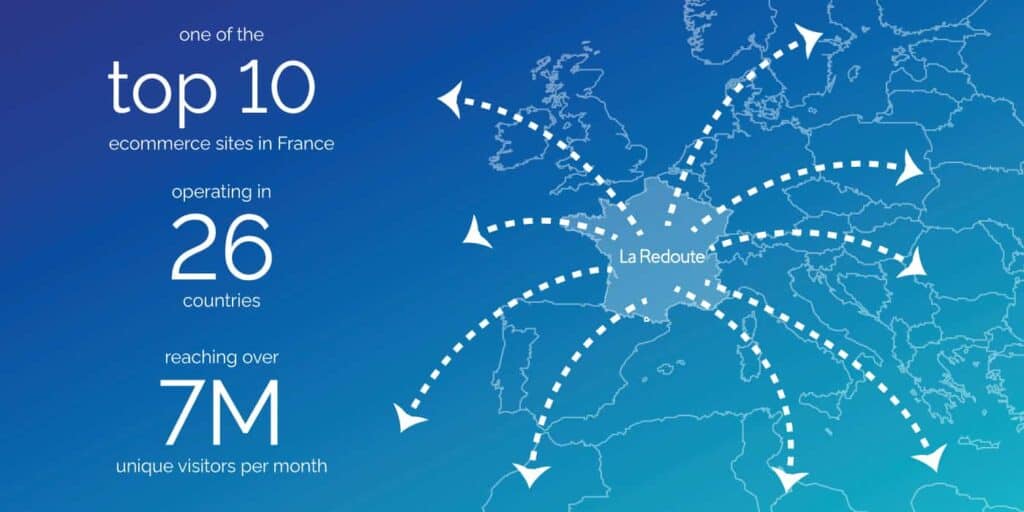
How La Redoute leverages Kubernetes to accelerate deployment of cloud native microservices
Challenge
La Redoute is a leading retail e-commerce company for families in Europe, with plans to accelerate the development of new products and services worldwide. However, in 2014 it was close to bankruptcy and had to pivot fast towards a complete digital transformation. “Our technology platform must be a business enabler. That starts by removing limiting factors,” said Antoine Craske, Director of Architecture & Technology.
Solution
After a few months of experimentation, the platform team decided to use Kubernetes as its orchestration platform. The company completed its ecosystem with CNCF projects that they identified as reliable and fitting, in the open-source culture of the company. The choices of technology matched the cloud-native and multi-cloud requirements essential to the transformation of application delivery.
Impact
Today, La Redoute is again a brand leader, serving more than 10 million customers. It benefits from streamlining its software delivery lifecycle – from development to operations. Creating a new service is now a matter of minutes, not days, and the adoption of the Kubernetes ecosystem has been growing steadily across its various platforms
By the numbers
Time from commit to Production
Reduced from days to less than 10 minutes
Deployments in production
Increased from 40 to 80 per day
Creating new services
Went from weeks to minutes

La Redoute is a retail company with 180 years of history. But in 2014, the company was near bankruptcy with more than 3,000 employees. Today, La Redoute is the only e-commerce brand to create, distribute, and deliver its product line from France to customers around the world – all while offering an unbeatable shopping experience, with accelerated growth worldwide through leveraging cloud native technology.
From Mail Order to Online
La Redoute was a pioneer in the mail-order business, creating the concept of “vente à distance”. Headquartered in Roubaix, northern France, in the center of Europe’s textile industry, its first catalog provided a broad range of products directly to end customers. This first move enabled La Redoute to grow rapidly, with 99% brand recognition in France. Every family recalls browsing the La Redoute catalog in their living room and this focus on bringing beauty to the family’s life has always been the DNA of the company.
La Redoute is also known for its transformational capability. The company was one of the first to offer 24-hour delivery, to launch a website, and a marketplace. But when the company was close to bankruptcy in 2014, it had to pivot fast and set out a four-year transformation plan to enable it to compete with the leading retailers who had expanded their online presence. Since 2014, the company has initiated an accelerated modernization of its IT landscape to drive the business transformation. The cloud native shift, in 2017, was one of its major evolutions.
Today, the company has been reborn from its ashes. It is one of France’s top 10 e-commerce sites with more than 10 million customers. La Redoute evolved to a pure e-commerce player, growing from 50% to 94% online sales. More than 70% of its product offerings come from internal brands and are available over 50 stores. It also introduced new business lines including home product line, B2B activity, and C2C for second-hand products. One of the most automated warehouses in Europe supports its operations.
Lift and Shift
The company used to deploy its application on-premises, lacking velocity on the developer experience, and its software lifecycle was one of the bottlenecks of processes and operational improvements. The front-end platform had been migrated in a “Lift & Shift” model to the cloud with some improvements (scale-out in 10 minutes, immutable servers, etc…) but did not yet leverage all the cloud capabilities. However, the back office function required a significant transformation to become a game-changer. This need for velocity, and the associated reliability and scale, led the teams to consider cloud native technologies as the next suitable investment.
The approach relied on the Accelerate metrics, which provide actionable guidance for organizations to improve their software delivery performance. According to the metrics, La Redoute’s IT systems ranged from Medium to High, depending on the application perimeter. The goal was to deliver at the Elite level for all newly created applications. The major requirements to meet were lead-time for changes, deployment frequency, change failure rate, and recovery capabilities.
A systemic approach was necessary to ensure a transformative evolution. The engineering teams evolved to feature-team and cross-functional team organizations. The architecture evolved to event-driven microservices for better decoupling and collaboration. Meanwhile, a platform team was formalized, with a mission to support these engineering teams in delivering high-quality software at speed. This platform team started to explore the cloud native landscape to select the most promising technologies to build upon, with ‘production-ready’ as a mandatory requirement.
Back in 2017, the cloud native landscape was less mature. With a mission of delivering production-ready microservices to accelerate the business, the platform team explored Docker Swarm and Kubernetes for orchestration, seeing it as an opportunity to learn the requirements of cloud native applications, like the externalization of configuration. Kubernetes remained the internal choice and was quickly adopted more broadly afterward in the market.
Complementary Technologies
La Redoute required complementary technologies to handle non-functional requirements such as security, monitoring, and recovery. The CI/CD platform choice to build a successful developer experience, among other possibilities, was Gitlab. Alongside, Kubernetes, Docker, Gitlab, and Grafana answered the requirement of portability for a multi-cloud trajectory. Helm charts were structured to ease the deployment of repeatable applications. Prometheus and Grafana were selected to build observability, and complement the existing ecosystem. The event streaming backbone and emerging use-cases of large-scale ingestion went to Apache Kafka.
The team worked collaboratively between architecture, engineering, infrastructure, operations, and security. An incremental approach to delivering tactical business projects enabled them to manage the risks while working on concrete use cases. After a series of iterations, the team finally reached the state of production-ready applications, and the platform was tested for delivery, incident, and operations. Reusable components, like CI/CD templates and libraries, eased the development experience. From that point, the team felt ready to deploy the platform for a strategic project.
The platform, leveraging the CNCF ecosystem, supported the teams successfully delivering the strategic project – vastly accelerating the speed of software delivery. Alongside, additional tactical projects also adopted cloud native applications. After a few months of iterations, La Redoute accelerated its overall delivery capability from 40 to 80 deployments per day.
Presently, the Kubernetes platform has been expanding on the back-end perimeter with cloud native reactive microservices. Deployment is started with a reactive micro-frontend architecture, leveraging the platform and associated tooling on the front-end. The capability to integrate technologies between these different perimeters enables the team to capitalize on their investment in the cloud-native architecture.
“Containerization was a de-facto choice for portable deployments, with Kubernetes for orchestrating them. We complemented our portfolio by limiting vendor lock-in, maximizing our flexibility, and containing the TCO.”
Maxime Drouet, Manager – Cloud & DevOps Team, La Redoute
Bye Bye Bottlenecks
The concrete results of this cloud native transformation have had a direct impact on the business, engineering, and infrastructure teams – now collaborating with an enabling platform team.
From a business perspective, engineering removed previous bottlenecks in its software development lifecycle. Strategic and tactical projects are much faster to deliver, with limited waiting times. While the platform cannot guarantee the success of new business features, it enables the business to meet its objectives via the Accelerate Elite metrics level.
Software engineers can now provision an application pipeline in minutes. From that point, they can perform rapid iteration – from development to operations – in less than ten minutes. Previously, they could wait days or weeks for infrastructure provisioning such as servers, pipelines, or observability components. The platform’s self-service, automation, and visibility make a significant difference.
For the operations teams – they save valuable time with self-healing capabilities, improvement in the availability and reliability of the platform. They now have the necessary time to dedicate to architecture and infrastructure-as-code priorities. This change of work is a challenge for the skills, interactions, and organization of infrastructure. But they can also work on more challenging, rewarding, and transformational activities.
Today, La Redoute continues to improve the platform’s usage in several areas such as onboarding, deployment, and security in a day-to-day mode. Again, the CNCF landscape provided suitable tools for the team’s needs. The team is now assessing Istio to resolve several limitations in network and security, and also exploring Jaeger to improve observability capability. ArgoCD is also a candidate to increase visibility of deployments. These priorities come from a better alignment with the business needs by streamlining the software delivery pipeline.
“Cloud native applications enable us to capture both economies of speed and scale by improving the developer experience, availability, and reliability. At the end of the day, we accelerate our business transformation.”
Antoine Craske, Director of Architecture & Technology, la redoute
Looking ahead, the expansion of the La Redoute family platform is the next challenge. The teams must support the international growth, scaling of the business is more complex and distributed environments. Concretely, the platform will expand into hosting more workloads in the back and front perimeters at a much larger scale. This expansion aims to compose the most desirable experience for customers.

